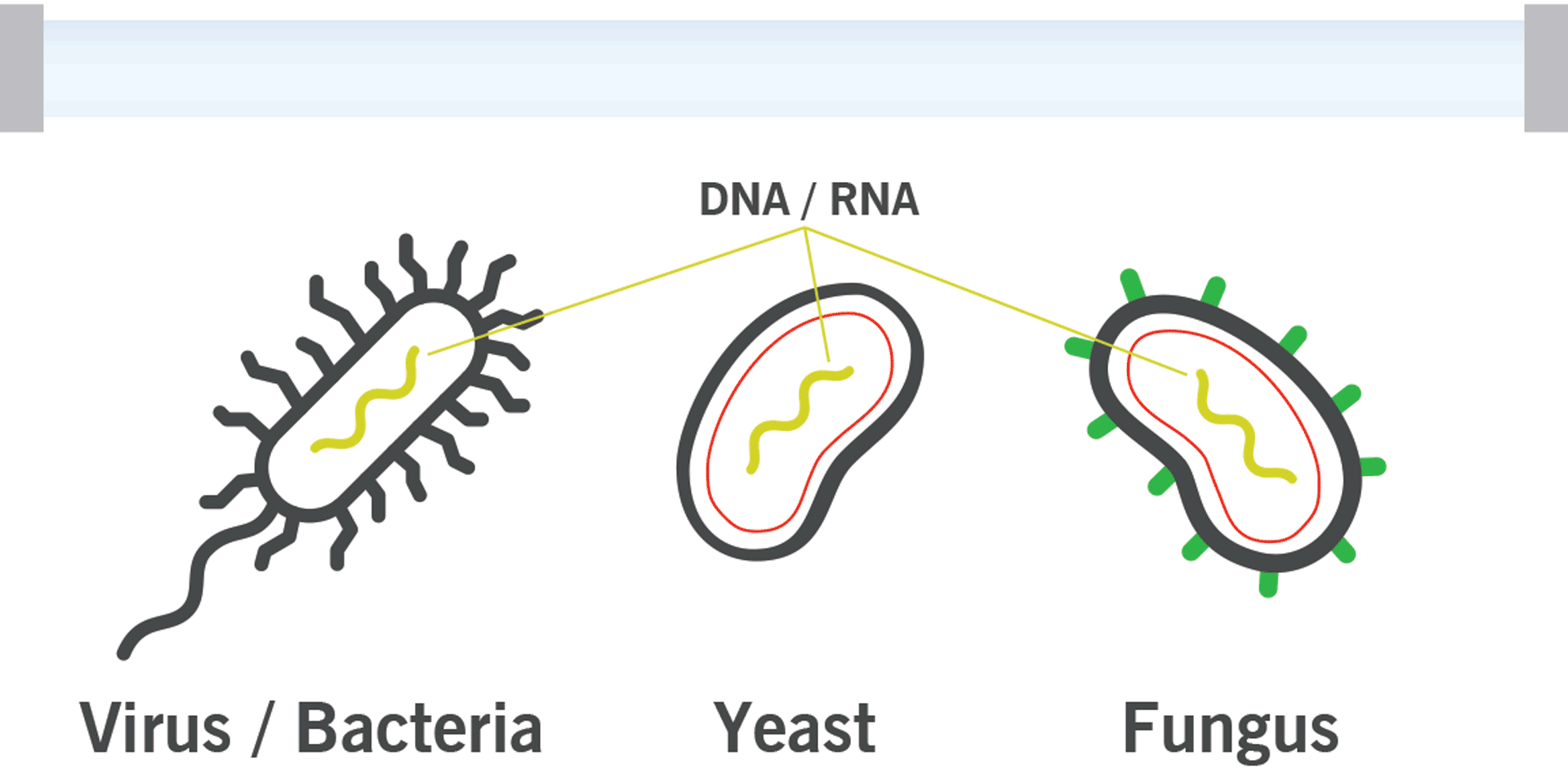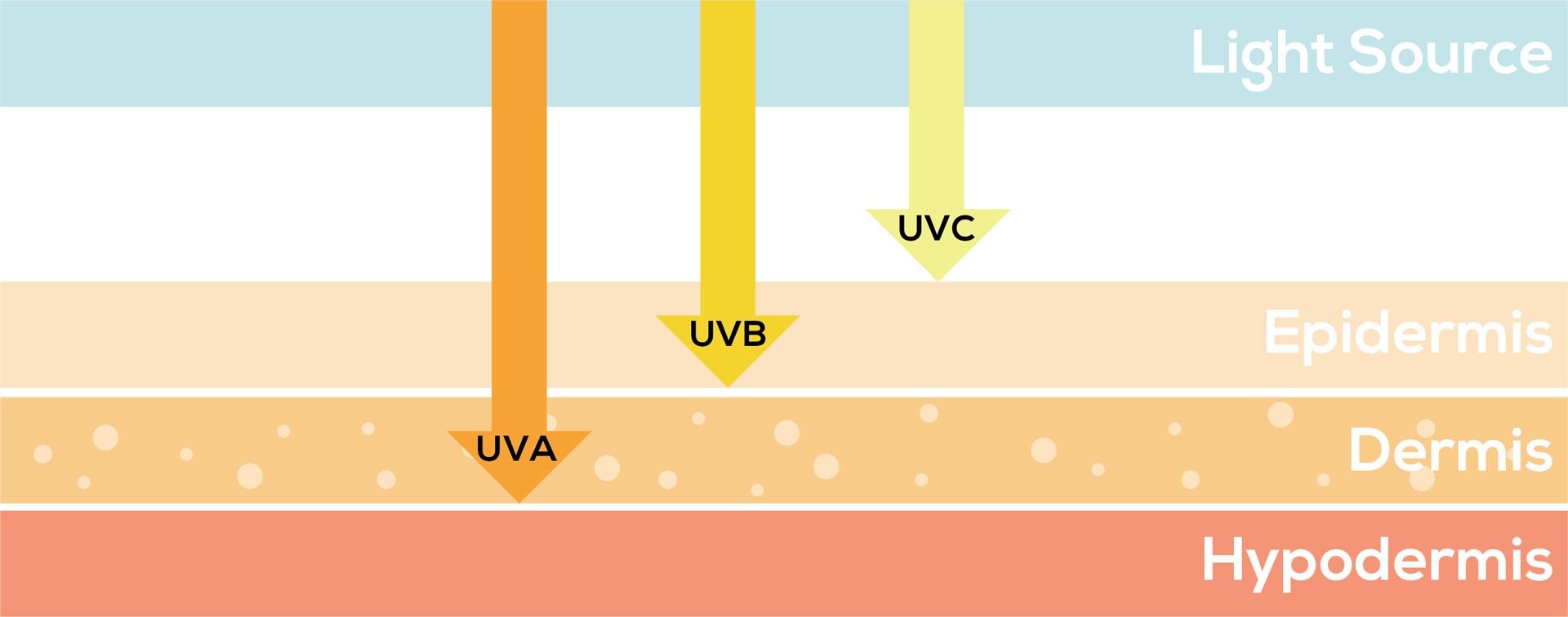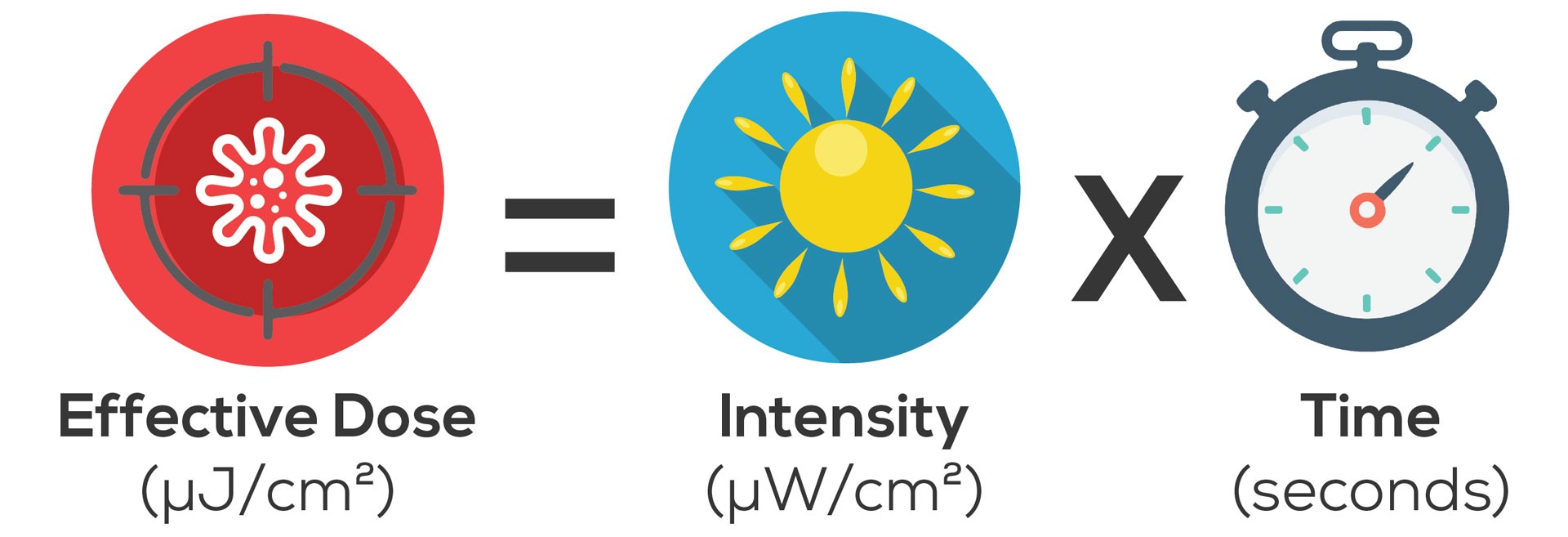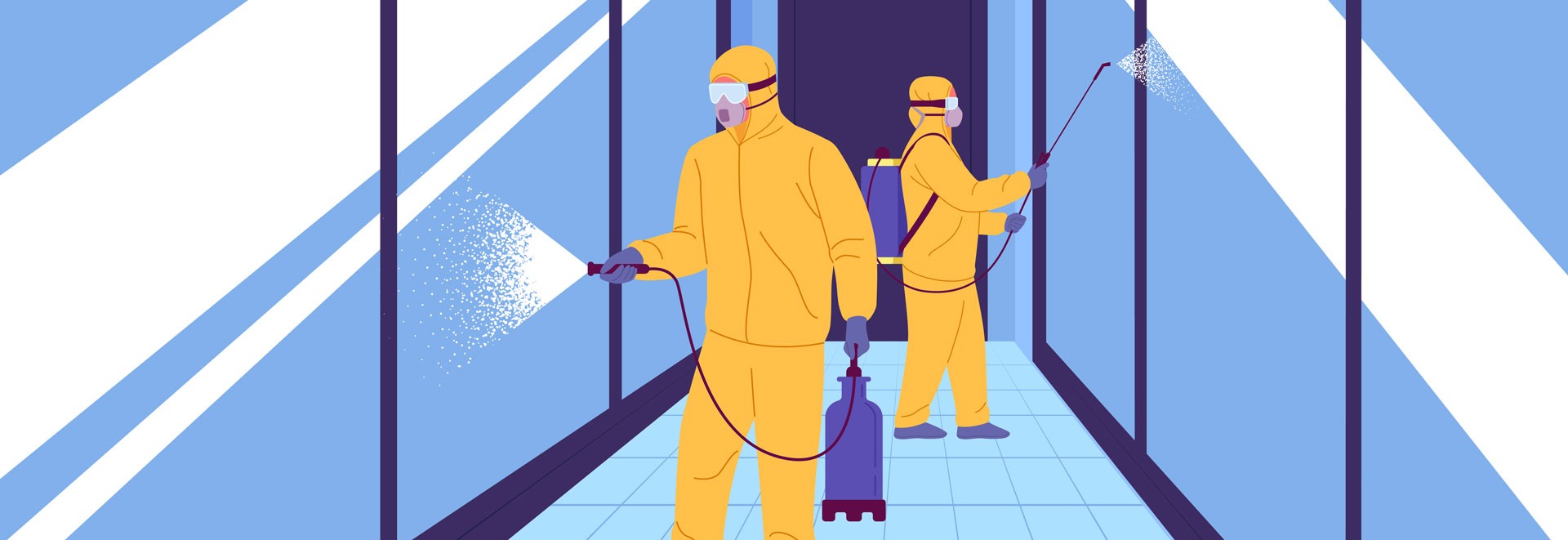UVC Sterilization Guide
Everything You Need To Know
What is UVC Light?

Ultraviolet light is naturally generated by The Sun, but it can also be created artificially for a variety of purposes. There are three types of UV energy (between 10-400 nm), which are classified according to their wavelength.
Short-wavelength UVC (100–280 nm) is the most active type of ultraviolet energy. Normally, UVC is blocked by the atmosphere and does not reach the earth’s surface. The shorter the wavelength, the more harmful the UV light is to cells. However, shorter wavelengths are the least capable of penetration.
Medium-wavelength UVB (280–315 nm) is very damaging and can penetrate through the superficial skin layers. It is responsible for delayed tanning and burning. In addition to these short-term effects, it enhances skin aging and significantly promotes the development of skin cancer.
Long-wavelength UVA (315–400 nm) accounts for about 95% of the UV radiation reaching the Earth’s surface. It can penetrate deeply into tissue and is responsible for the immediate tanning effect. It also contributes to skin aging and wrinkling. Recent studies strongly suggest that it may also enhance the development of skin cancers.
How Does UVC Disinfect Germs?

UVC technology has been in use by hospitals for its clinically validated effectiveness in sterilizing germs since the 1930s. Any living cell that is exposed to UVC light will be affected—including viruses, bacteria, yeast, mold, algae, amoebas, and allergens.
The UVC energy penetrates outer layers of a cell and is absorbed in the DNA or RNA, damaging nucleic acids. Once nucleotides are fused, a microorganism is inactivated by losing its ability to reproduce and infect. This entire process happens within seconds of adequate UVC exposure.
Simple-structure organisms like viruses and bacteria are the most vulnerable to ultraviolet light, whether they are airborne or on a surface.
Is UVC Light Safe?

Safety is a relative term and depends on proper usage and handling. Although UVC light permeates simple organisms relatively easily, the complex cell structures of plants and humans are resistant to these low-energy wavelengths. High energy wavelengths of UVA and UVB can penetrate deep into the skin layers and cause significant damage.
UVC lamps should be treated with as much caution as other forms of ultraviolet light and are typically used in unoccupied rooms. Even though the outer layer of human skin or a thin layer of clothing blocks UVC rays, care should be taken to avoid direct exposure of UV to bare skin and eyes.
With proper PPE that covers the eyes and skin, being near an active UVC device is completely safe. Without any PPE, prolonged or direct exposure to UVC light can cause temporary eye irritation and skin redness but has not been shown to cause skin cancer or cataracts.
Care should be taken to only use products with adequate safety measures. For a small device like a wand, simply having a gravity sensor that prevents the light from turning on when facing upward is sufficient. In the case of a larger device that sterilizes a room, it needs a motion detector so the light will shut off if anyone enters the area. Other safety features can include timers, child locks, pressure switches, audio cues, and remote controls.
How Do UVC Devices Work and What Types Are Available?

For a UVC device to work effectively, a combination of science and mathematics must be considered. The factors that quantify an effective dose of UVC for sterilization are:
- Ultraviolet intensity (determined by lamp output and distance from subject)
- Exposure time
As distance from a subject is increased, the exposure time or output strength must also increase. For example, a high-powered lamp in an HVAC system can instantly disinfect air moving quickly past it. To disinfect entire rooms with a mobile unit from a distance, the device should run longer. Therefore, the instructions for a UVC device need to be clear and backed by real data and not simply assumptions.
- Low-pressure mercury lamps are the most common and have been around the longest. They emit a highly germicidal wavelength of 253.7 nm. One thing to note about mercury lamps is they can also produce ozone, which is toxic. The bulbs can be treated to prevent this.
- High-pressure mercury lamps emit very intense broad-band UVC radiation. They are typically used for air and water purification but only last 1-2 years and require regular maintenance.
- Induction lamps also emit very intense UVC radiation. This technology is inherently more stable due to its lack of electrodes which allows it to last up to 10 years without any maintenance.
- LEDs can be made to emit UVC at about 270-280 nm, which is at the top end of the spectrum. To be effective they need higher intensity because the ideal germicidal wavelength is lower.
- Excimer lamps emit narrow-band UVC at 207 and 222 nm. They are also referred to as “far-UV”. Early testing has shown them to be human safe, but this wavelength is less effective at disinfection.
- Contained UVC devices are safe to operate anywhere since objects are placed inside for disinfection. They come in a variety of sizes and functions like bags, cell phone chargers, and even lamps that you can place inside of storage containers.
- Handheld UVC devices are meant to be used manually on surfaces and objects although should not be pointed at skin. They are highly portable and easy to use but do not cover a large area.
- Mobile room sterilizers are placed in the center of an unoccupied room to disinfect surfaces and the air. It is important for them to include a motion sensor to prevent accidental exposure.
- Intelligent disinfection fixtures are automated and stay in a room permanently. Usually found in businesses, they are programmed to run on a schedule when no personnel are present.
- Air and water purifiers run behind the scenes and have an extremely high intensity. You will often find these inside of HVAC systems, which keeps the air clean but does not affect surfaces.
- Far-UVC is relatively new technology that is still being studied. While early testing has shown that these systems are human safe and can be used in occupied rooms, precautions should still be taken.
How Do I Know If My Device Works?

The best indicator of whether a particular product is emitting a high enough dosage of UVC to be effective (or any UVC at all) is by looking at independent laboratory reports. Since the light works at a microscopic level, we cannot see visual effects and studies should be done in a controlled environment to validate how effective a product is. These scientific facilities have access to equipment like spectrometers to measure light wavelengths, and high-powered microscopes to analyze results.
You can also purchase test strips and cards that change color shades depending on the intensity of UVC light it is exposed to. It is important to note that these tests come in a variety of styles and the appropriate version needs to be purchased to detect UVC. A low-tech experiment that some perform is to expose the skin of a banana to a UVC device to see if it visually oxidizes. However, this method should not be considered definitive.
Another clue as to the product quality is the certifications it has. Components or entire devices should be listed with a safety certification company like UL or ETL. Products should also be registered with the EPA (Environmental Protection Agency) and have full FDA (Food and Drug Administration) compliance.
What Red Flags Should I Look Out for With UVC Devices?

The reason UVC product quality varies so widely is because standards are still being established and the industry is not highly regulated. This allows ineffective and even fake UVC products to flood the market. Warning signs of an inferior product include:
- Products that do not list UVC output intensity or even device wattage
- Products which mention intensity but neglect the distance from which it was measured
- Products which have not been tested in a laboratory to validate effectiveness
- Products with poorly written or vague instructions
- Products with a lack of proper certifications and safety listings
- Products missing critical safety features like motion detectors, timers, gravity sensors, etc. (What is considered critical varies depending on model type)
- Products on eCommerce websites from companies that do not have a clear background, website, or storefront
- Products with unclear and incomplete specification sheets. (Such as failing to specify the bulb sleeve material, as it could likely be cheap soft glass which is less durable and less effective than quartz or fused silica)
- Companies that do not offer warranties or have strict return policies
- Companies that cannot specify what components are used and why, and do not know what they are selling because they are not manufacturers
- Companies that include misleading information in marketing material (like bogus claims or photos showing a device used on pets and objects being held)
- Companies with reluctant, slow, or unknowledgeable customer support
Why Use UVC Over Other Cleaning Methods?

Currently there are many different solutions available to help keep people and businesses safe. Protective equipment like acrylic dividers and face shields are on the rise. Sanitary wipes and sprays are being used more frequently. However, possible downsides to manual cleaning methods include labor, cross-contamination, and human error.
Chemical foggers and electrostatic sprayers are becoming more popular. The main issue with these devices is they only affect surfaces and lack the ability to sterilize the air. They also have recurring costs, require more time, and spread toxic chemicals.
Air purification systems are a fantastic way to keep the air clean without manual intervention. They are very effective at keeping the concentration of harmful airborne particles low. Due to their contained design, air purifiers can be cycled while a space is occupied. To keep surfaces sterilized other solutions can be used in tandem.
Ultraviolet light is a fantastic alternative to any other disinfection system. It is one of the only methods that can effectively sterilize surfaces and the air simultaneously. Pathogens cannot become resistant to UVC like they can with antibiotics and biocides. In fact, UVC light works indiscriminately against every known microorganism. No chemicals or residue is left behind so UVC devices are hypoallergenic and environmentally friendly. There are no recurring purchases or maintenance. Best of all, UVC devices are extremely easy to use and require little to no manual labor.
One important thing to note is that UVC is not considered a replacement for normal sanitary procedures. Guidelines outlined by the CDC (Centers for Disease Control and Prevention) such as social distancing, hand washing, face masks, etc. are still recommended.
What Does All This Mean for Me?

For decades, UVC light has proven to be a safe and effective way to sterilize critical areas and sensitive equipment. Due to the recent pandemic this technology has seen a surge in popularity as businesses and consumers apply it to more areas. UVC light is a powerful solution against all viruses that will only become more relevant in our globalized world where pathogens like influenza can spread almost as fast as information.
The best way to get started using this technology in your own life is to research and compare UVC products. Finding the right solution for you depends on your individual needs. Do not hesitate to ask questions during your research process and share your ideas. Any knowledgeable company should be able to explain your options and how to best achieve your goals.


